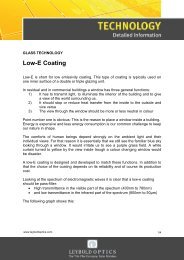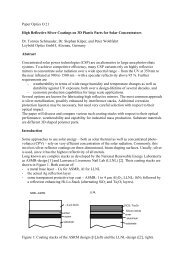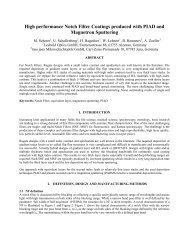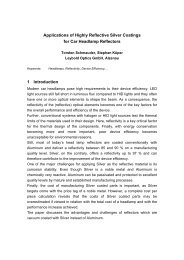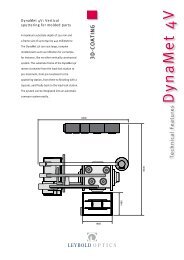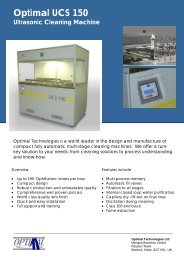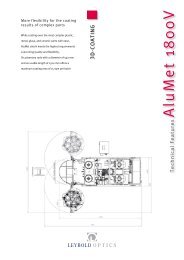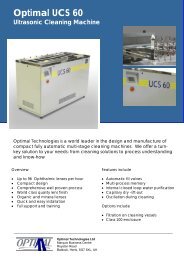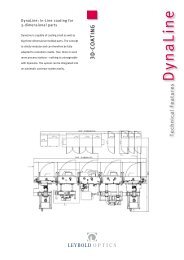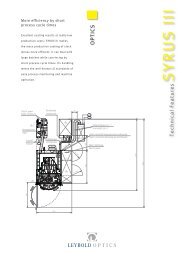CAPACITOR TECHNOLOGY DISS â Dual In ... - Leybold Optics GmbH
CAPACITOR TECHNOLOGY DISS â Dual In ... - Leybold Optics GmbH
CAPACITOR TECHNOLOGY DISS â Dual In ... - Leybold Optics GmbH
You also want an ePaper? Increase the reach of your titles
YUMPU automatically turns print PDFs into web optimized ePapers that Google loves.
<strong>CAPACITOR</strong> <strong>TECHNOLOGY</strong><br />
<strong>DISS</strong> – <strong>Dual</strong> <strong>In</strong>-Situ Sensor<br />
<strong>In</strong>troduction<br />
<strong>In</strong> order to increase productivity and to reduce scrap of web metalizing systems, a<br />
tailor-made, real time, in-situ monitoring system is required. Such a system will<br />
enable an operator to detect all quality relevant deviations in an accurate and<br />
immediate way. Thus, necessary corrections can be performed and supervised<br />
without delay.<br />
Especially high-technology products like metalized capacitor film, produced with<br />
maximum speed, demands tight tolerances of layer homogeneity and maximum<br />
precision of dimensions.<br />
The sheet resistance or optical density as measurement for layer thickness and the<br />
width of the free margin are the two features of metalized capacitor film which are<br />
continuously measured during production.<br />
Fig 1: <strong>DISS</strong> monitor - screen shot with layer profile in transverse direction<br />
www.leyboldoptics.com<br />
1/3
<strong>In</strong>novation<br />
The <strong>DISS</strong> <strong>Dual</strong> <strong>In</strong>-Situ Sensor is a combination of one line sensor for layer thickness<br />
measurement and one line sensor for the measurement of free margins in one<br />
chassis. Additionally to the sensor, the <strong>DISS</strong> system is completed with a separate<br />
PC, including monitor, with a link to the machine controller.<br />
The layer sensor measures the optical density in real time with a high spatial density<br />
of sensors and a high speed of data acquisition. The layer in active area and heavy<br />
edge is measured simultaneously. The homogeneity can be supervised in<br />
transverse and in machine direction. The dynamic range for the layer thickness<br />
goes from 0 up to 3 O.D.; the refreshing rate for a complete set (layer profile in<br />
transverse direction) of measuring values is 50 µs. The sensor allows the<br />
measurement of pattern structures down to 3 x 3 mm², even at theoretical process<br />
speeds of 20 m/s.<br />
The second line sensor is used to measure all free margins simultaneously, with the<br />
same refreshing rate. Thus, the uniformity of the margins can also be controlled in<br />
transverse and in machine direction. The resolution of the width of the margins is<br />
less than 50 µm.<br />
www.leyboldoptics.com<br />
Fig 2: <strong>DISS</strong> sensor<br />
2/3
Advantages and benefits<br />
• Flexibility.<br />
- Suitable for pattern applications with marginal parameters for structure<br />
dimensions and process speed.<br />
- Suitable for special processes (e.g. Al/Zn-HE – pure aluminium in<br />
active area and aluminium/zinc in heavy edge).<br />
- Suitable for standard processes.<br />
• Constant product quality.<br />
- Real time measurement even for maximum process speed.<br />
- Full area supervision of homogeneity.<br />
- No signal driftduring operation.<br />
• Higher productivity.<br />
- Drastically reduced scrap.<br />
- Minimum effort for setup and calibration.<br />
- <strong>In</strong>-situ indication of symmetrical arrangement of heavy edge between<br />
free margins. No additional effort for setup after product changes.<br />
- Minimum effort for product development.<br />
• Simplified design.<br />
- No additional hardware required to establish the condition for the<br />
measurement.<br />
www.leyboldoptics.com<br />
3/3



